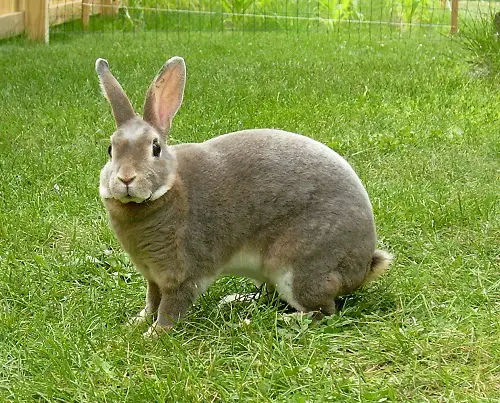Rex rabbits
Basic Appearance:
Rex were the first rabbit breed to have the gene that causes rex fur. They are medium-large, commercial type rabbits with soft, velvety fur coats. They come in a large variety of colors, all in the luxurious plush fur, which is short, thick, and stands upright. The guard hairs are short, exposing the thick undercoat. This is what gives rex their incredibly soft fur.
History, Temperament, and Common Uses:
The rex gene was first discovered in France. A peasant showed some of his unusual rabbits to another fancier, M. Amadee Gillet, who started breeding these new rabbits. By 1924 he had them developed into a breed he called the castorrex. Castorrex means “Beaver King.” Beaver was in reference to the color of the fur, which was a reddish brown similar to beaver pelts. Rex means king, and with their unique coats it’s easy to see where this part of the name comes in. The rex spread rapidly throughout Europe and America, and was recognized by the ARBA in 1958. People sometimes call rex “standard rex” to differentiate between the rex and mini rex breeds.
Rex rabbits are usually calm, good natured, and friendly, enjoying attention from people and other rabbits. They are sometimes likened to cats in temperament. Rex are very intelligent rabbits as well.
Rex are usually show rabbits. Although they have been somewhat overshadowed by the popular mini rex, rex still have a devoted following in the show room. Rex are a meat type breed, and are sometimes used for meat and fur production. Rex also make great pets if you have the room for them. Their size makes them harder to handle than smaller breeds, but they make up for it with their gentle temperament.
Grooming, Care, and Additional Notes:
Rex fur is easily damaged by grooming with the wrong kind of brush. For show rabbits, grooming should be done with slightly damp hands, followed by going over the coat with a lint roller or a section of a hacksaw blade. Pet rabbits can be groomed gently with a wide-toothed brush followed by a soft bristle brush. Rex will need more frequent grooming during a molt. Their claws will need trimmed once a month.
Rex sometimes have thin fur on their footpads. You may need to provide a resting mat for them to sit on if you use a wire-floored cage.
Rex At A Glance…
Recognized Varieties:
Amber, black, blue, broken group, Californian, castor, chinchilla, chocolate, lilac, lynx, opal, otter, red, sable, seal, and white.
ARBA Body Type:
Commercial
Approximate Size:
7 1/2 to 10 1/2 pounds.
Important Things to Look for When Buying Show Stock:
A well-proportioned rabbit with nicely balanced type. Rex are commercial type rabbits, and should be of medium body length, having broad, rounded hindquarters, full and well developed. Rex should have full, meaty loin, ribs, back, and shoulders. The rabbit should be smooth and firm of flesh. There should be good depth of body, in balance with the rest of the rabbit. When viewed from the side the topline should start at the base of the ears and rise in a gradual curve with its highest point over the hips. From there it should round smoothly down to the base of the tail. Looking down on the rabbit there should be a slight taper from the widest point at the hindquarters to the shoulders.
Look for a head that is broad, set close to the body, and in proportion with the rest of the rabbit. The ears should be well set, carried erect, and of medium thickness. The eyes should be bright.
Rex should be of medium bone, with rather short legs. Feet should have plenty of fur on the pads. Colored varieties should have dark claws. Californian should have horn colored claws, and white should have white or flesh colored claws. Brokens are not disqualified for one or more colored claws.
Rex fur should be very dense, upright, and the same length over the entire body, with a springy feel when touched. The coat should have a lustrous appearance and be very thick, smooth and plushy.
Things to Avoid:
Narrowness of shoulders or body. Long body, flabby belly, short, cobby body. Chopped or undercut at the hindquarters, fine bone, long legs. Very rangy or racy rabbits will be disqualified. Long head, pointed muzzle, head too small to balance with the rest of the rabbit. Thin ears or ears too long to balance with the rest of the rabbit. Claws not matching on any variety except brokens is a disqualification. Fur lacking luster, noticeable protruding guard hairs, curly, harsh, or wiry coat. Uneven, soft, silky fur that lies flat when stroked. Any fault of the coat that destroys typical rex appearance, or average fur length greater 7/8 in. or less than 1/2 in. will be disqualified.


